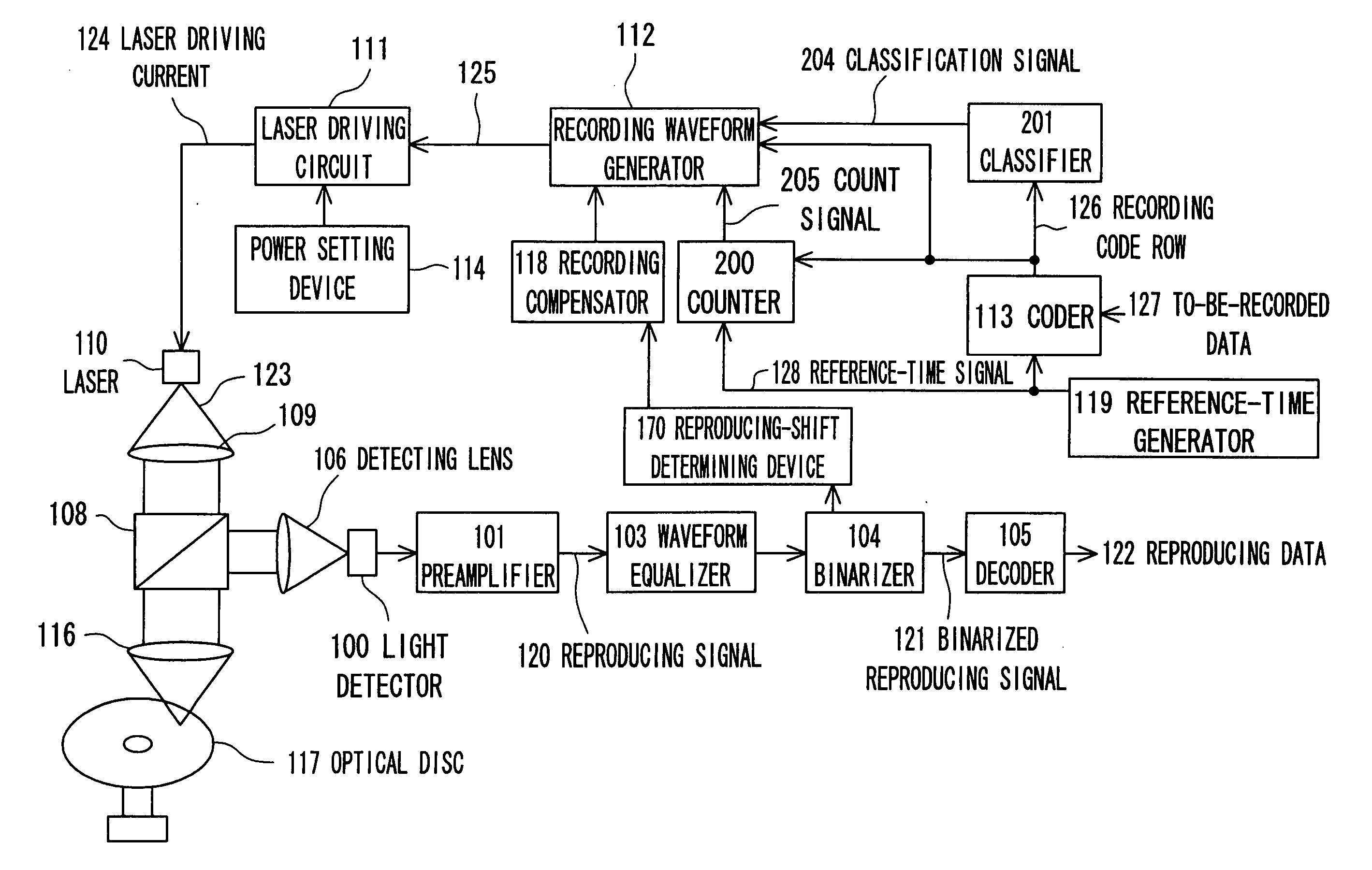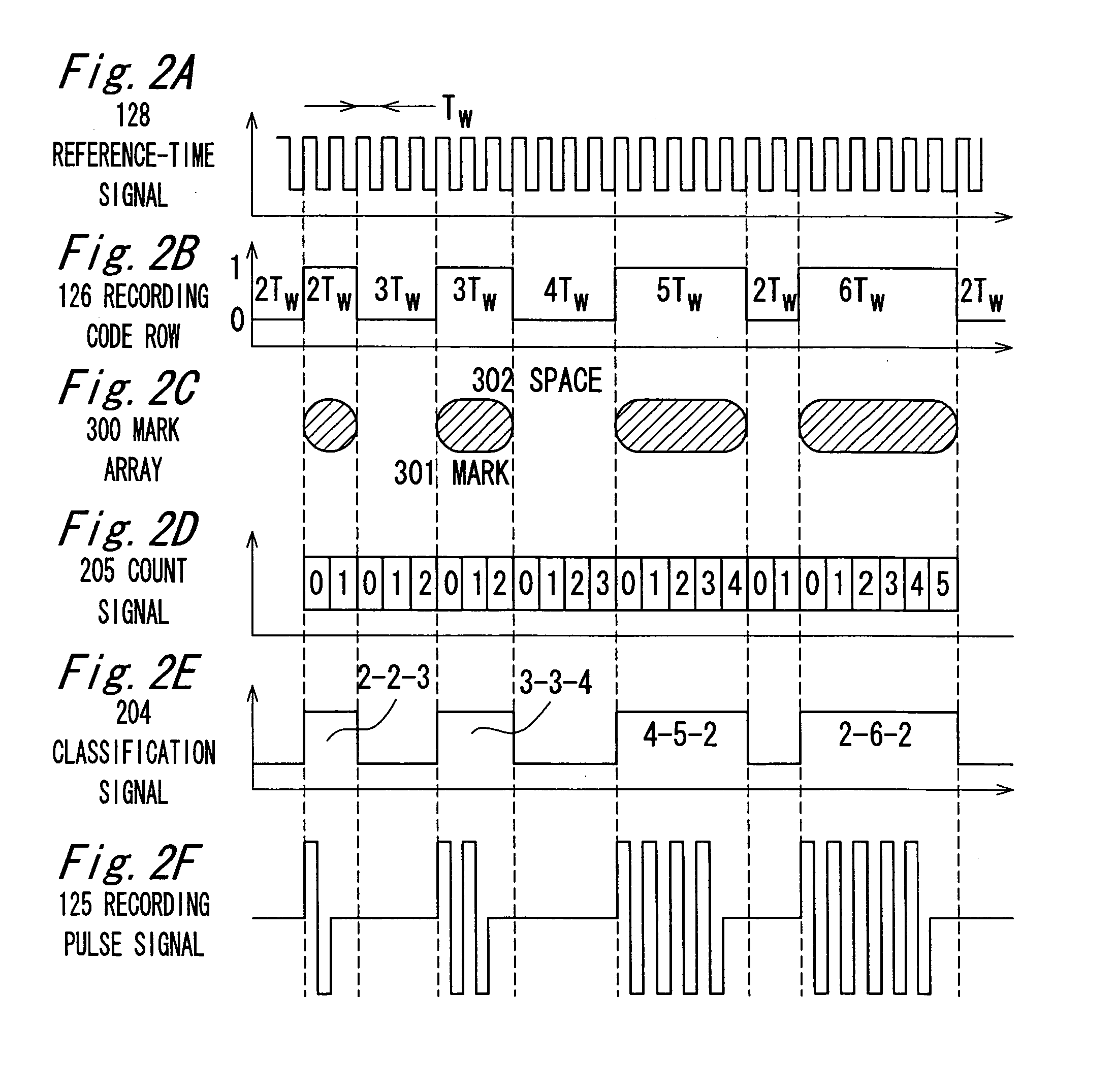Method and device for optical recording onto optical disc medium
a technology of optical disc and recording method, which is applied in the field of optical recording method and optical recording apparatus, can solve the problems of increasing the error ratio during reproduction, heat interference, and the inability to largely increase the recording linear density, and achieve the effect of improving the reliability of recording/reproducing operation
- Summary
- Abstract
- Description
- Claims
- Application Information
AI Technical Summary
Benefits of technology
Problems solved by technology
Method used
Image
Examples
first embodiment
[0045]FIG. 1 is a block diagram illustrating the structure of an optical recording / reproducing apparatus according to the first embodiment of the present invention. This optical recording / reproducing apparatus includes, as a recording system, a coder 113, a reference-time generator 119, a counter 200, a classifier 201, a recording waveform generator 112, a recording compensator 118, a laser driving circuit 111, a power setting device 114, a laser 100 and an optical system including an objective lens 116. Further, this optical recording / reproducing device includes, as a reproducing system, the optical system including a detecting lens 106, a light detector 100, a preamplifier 101, a waveform equalizer 103, a binarizer 104, a decoder 105, and a reproducing-shift determining device 170. Further, the aforementioned optical system includes a collimating lens 109 and a half mirror 108, in addition to the objective lens 116 and the detecting lens 106.
[0046] First, the respective component...
second embodiment
[0102]FIG. 9 is a timing chart illustrating the relationship between the mark lengths of marks to be recorded and the recording pulse signals 125, in an optical recording method according to the second embodiment of the present invention. This optical recording method is different from the optical recording method according to the first embodiment in that the width Tlp of the last pulse at the peak power level (Pw) is adjusted in accordance with the result of classification of marks by mark length and succeeding space length. As the width of the last pulse Tlp, a total of 2*4=8 types of values (o1 to o8) are defined for the mark lengths of to-be-recorded marks which are classified into two types of mark lengths 3T and 4T and more and for the preceding space lengths classified into four types of spacing lengths 2T, 3T, 4T and 5T and more, as represented in the following Table. 15.
TABLE 15The mark lengthTlp3T>=4TThe preceding space length2To1o23To3o44To5o6>=5T o7o8
[0103] By class...
third embodiment
[0104]FIGS. 10A to 10J are timing chart illustrating the relationship between the mark lengths of marks to be recorded and the recording pulse signals 125, in an optical recording method according to the third embodiment of the present invention. This optical recording method is different from the optical recording method according to the first embodiment in that the recording pulse signals 125 have waveforms in which the number of middle pulses is not proportional to the mark length value. According to the optical recording method, as illustrated in FIGS. 10C to 10J, the recording pulse signals for marks having mark lengths of 2Tw, 3Tw and 4Tw have a single pulse at the peak power level. The recording pulse signals 125 for marks having mark lengths of 5Tw and 6Tw have two pulses at the peak power level. The recording pulse signals 125 for marks having mark lengths of 7Tw and 8Tw have three pulses at the peak power level. The recording pulse signal 125 for a mark having a mark lengt...
PUM
| Property | Measurement | Unit |
|---|---|---|
| frequency | aaaaa | aaaaa |
| linear speed | aaaaa | aaaaa |
| wavelength | aaaaa | aaaaa |
Abstract
Description
Claims
Application Information
 Login to View More
Login to View More - R&D
- Intellectual Property
- Life Sciences
- Materials
- Tech Scout
- Unparalleled Data Quality
- Higher Quality Content
- 60% Fewer Hallucinations
Browse by: Latest US Patents, China's latest patents, Technical Efficacy Thesaurus, Application Domain, Technology Topic, Popular Technical Reports.
© 2025 PatSnap. All rights reserved.Legal|Privacy policy|Modern Slavery Act Transparency Statement|Sitemap|About US| Contact US: help@patsnap.com



